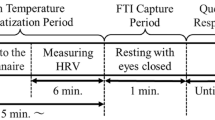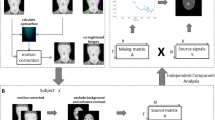Abstract
The amount of mental work using information equipment has been increasing because of a rapid growth of an information society. Accumulation of short-term mental work can cause various stresses and a disturbance of circadian rhythm and lead to fatigue, anxiety, and distraction. Estimation and understanding the physiopsychological states is desired for decreasing or controlling stresses to maintain health. There have been several investigations on the assessment of short-term physiopsychological states using infrared thermography. However, the method has been used rarely for assessing long-term physiopsychological states. In the present study, extraction of independent components related to long-term physiological signals is attempted by applying independent component analysis to facial thermal images obtained over 6 months (July–December). Furthermore, multiple regression analysis is attempted to create psychological model by facial thermal images. As the result, extracted independent components are shown to represent the strong features in nasal, mouth, cheek, eyebrow, and forehead regions. Attempting multiple regression analysis, features in nasal and mouth regions contributed to depression or dejection mood, features in cheek, eyebrow and forehead regions contributed to fatigue and features in tip of nasal, eyebrow and mouth regions contributed to state anxiety.




Similar content being viewed by others
Explore related subjects
Discover the latest articles, news and stories from top researchers in related subjects.References
Nachreiner F (1999) International standards on mental work-load—the ISO 10 075 series. Ind Health 31:125–133
Ohsuga M, Terashita H, Shimono F (2009) Towards the assessment of mental workload using autonomic indices. Trans Soc Instrum Control Eng 29:979–986
Yoshida T (1990) The measurement of EEG frequency-fluctuation and evaluation of comfortableness. Acoust Soc Jpn 46:914–919
Yamakoshi T, Yamakoshi K, Kusakabe M (2005) Physiological investigation of automobile driver’s activation index using simulated monotonous driving. Trans Soc Automot Eng Jpn 36:205–212
Shirakawa S (2008) Ambulant long-term monitoring of activity and body temperature. Trans Jpn Soc Med Biol Eng 46:160–168
Zenju H, Nozawa A, Tanaka H, Ide H (2004) Estimation of unpleasant and pleasant states by Nasal thermogram. IEEJ Trans Electron Inf Syst 124:213–214
Iwata H (1988) Quantitative evaluation of mental work by thermography. Trans Soc Instrum Control Eng 24:107–111
Japan Society of Physiological Anthropology, Human Measurement Hand Book, Asakura Shobo (1996)
Nozawa A, Uchida M, Nagamine K, Ide H (2004) Quantitative evaluation of deliciousness by pleasant-unpleasant emotions on gustatory stimulus. IEEJ Trans Electron Inf Syst 124:1795–1796
Mizuno T, Nomura S, Nozawa A, Asano A, Ide H (2010) Evaluation of the effect of intermittent mental work-load by nasal skin temperature. IEICE Trans Inf Syst 93:535–543
Okamoto R, Bando S, Nozawa A (2016) Blind signal processing of facial thermal images based on independent component analysis. IEEJ Trans Electron Inf Syst 136:1142–1148
Hyvarinen A, Oja E (1997) A fast fixed-point algorithm for independent component analysis. Neural Comput 9:1483–1492
Matthew SG, Christopher MB, Douglas JC, Shannon MB, Susan WY, Brendon PM, Lindsay MB, Paul WB, Lawrence EA, Carl MM (2009) Validity and reliability of devices that assess body temperature during indoor exercise in the heat. J Athl Train 44:124–135
Jung D, Kim H, Koh K (2000) Arterial supply of the nasal tip in Asians. Laryngoscope 110:308–311
Author information
Authors and Affiliations
Corresponding author
Additional information
This work was presented in part at the 22nd International Symposium on Artificial Life and Robotics, Beppu, Oita, January 19–21, 2017.
About this article
Cite this article
Oiwa, K., Okamoto, R., Bando, S. et al. Blind source extraction of long-term physiological signals from facial thermal images. Artif Life Robotics 23, 218–224 (2018). https://doi.org/10.1007/s10015-017-0423-9
Received:
Accepted:
Published:
Issue Date:
DOI: https://doi.org/10.1007/s10015-017-0423-9




